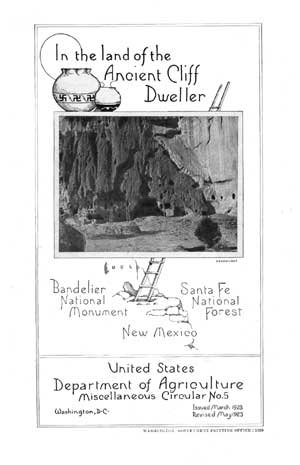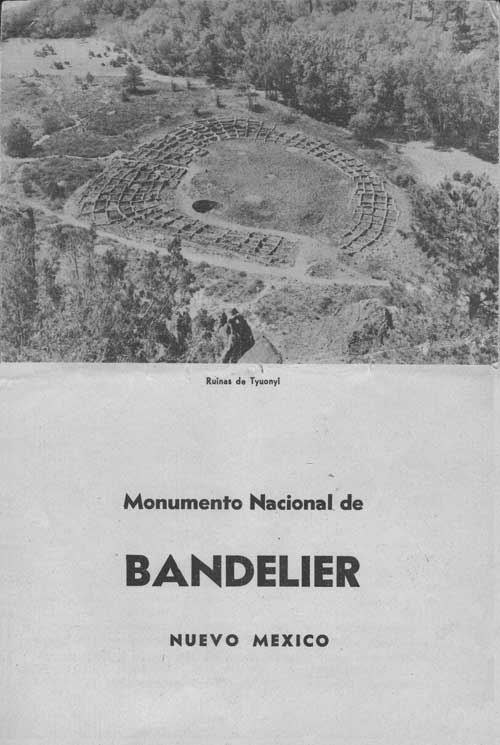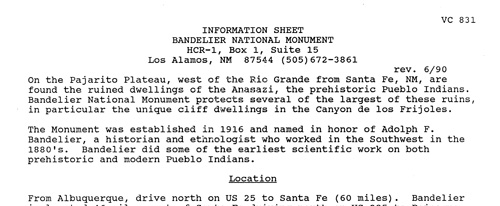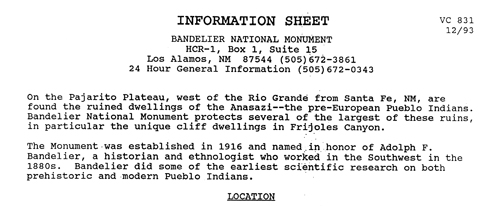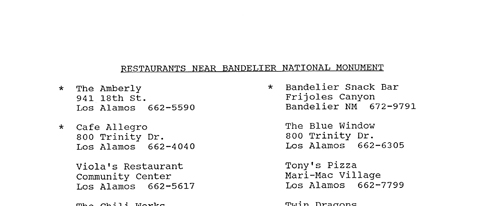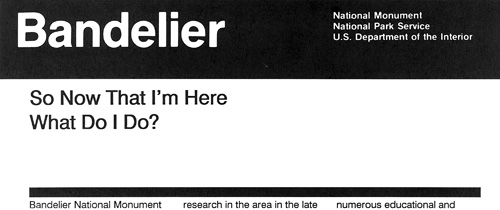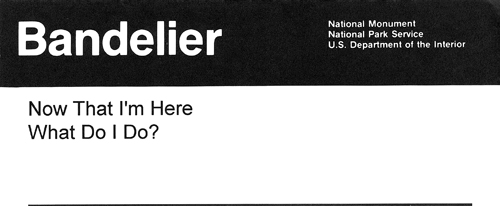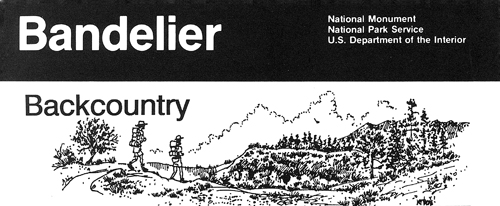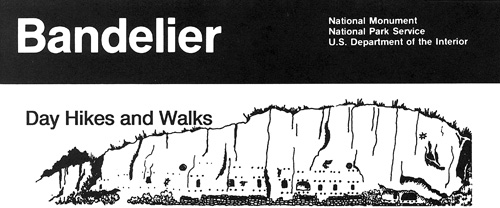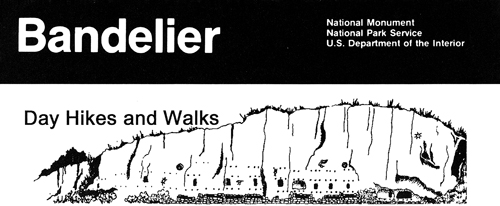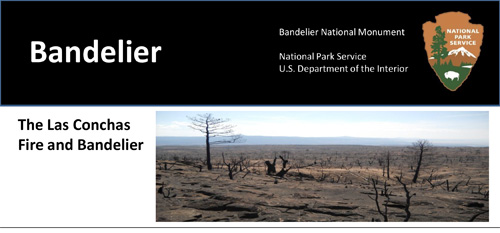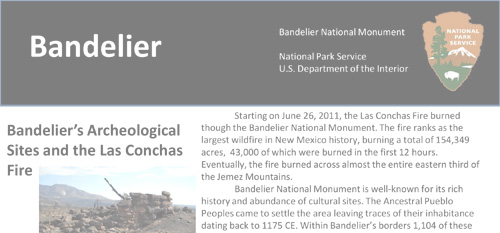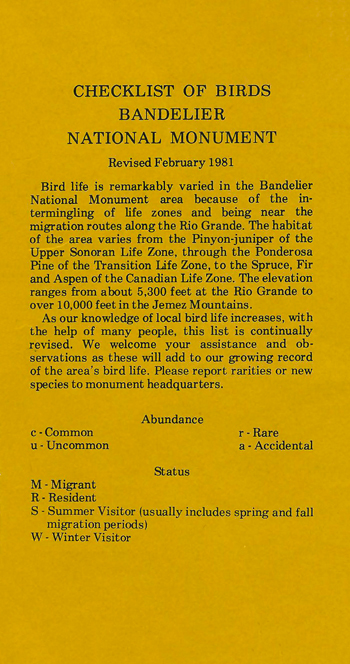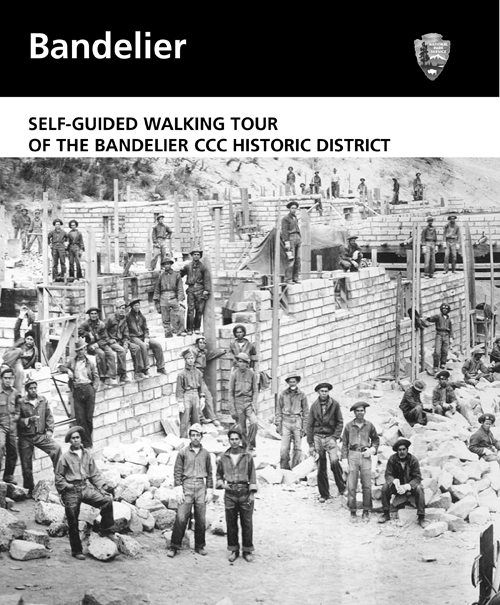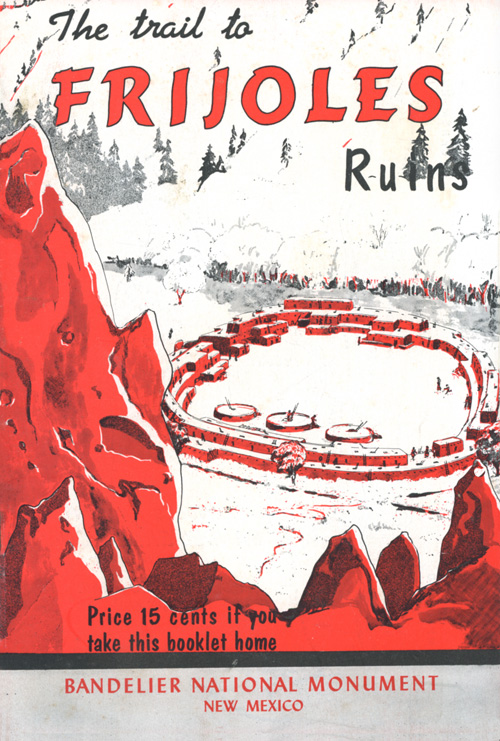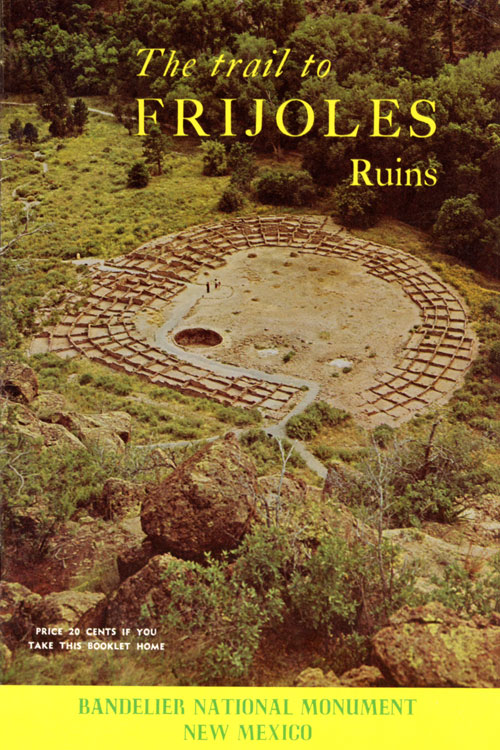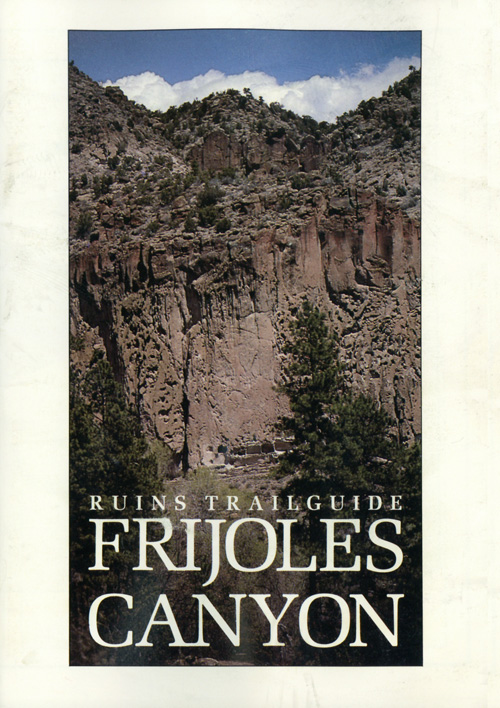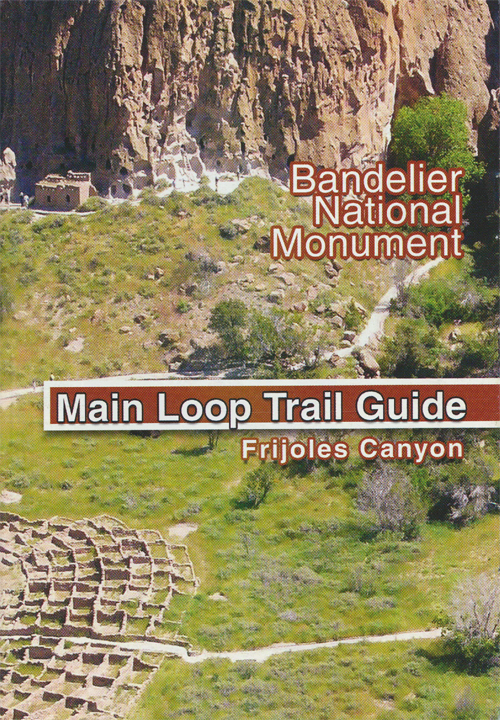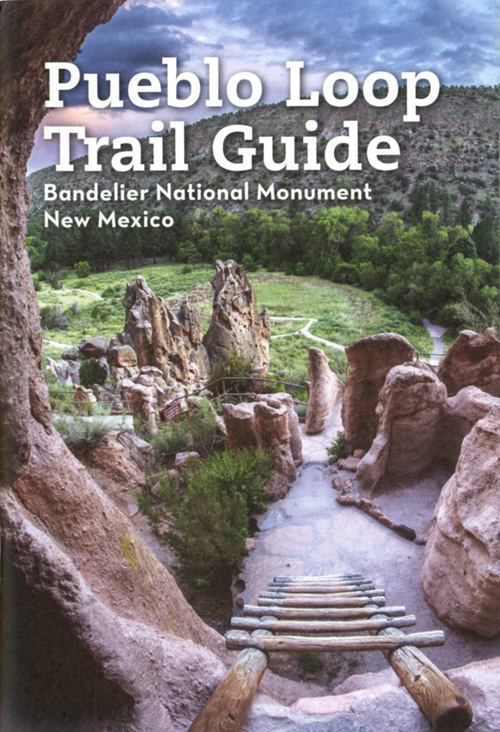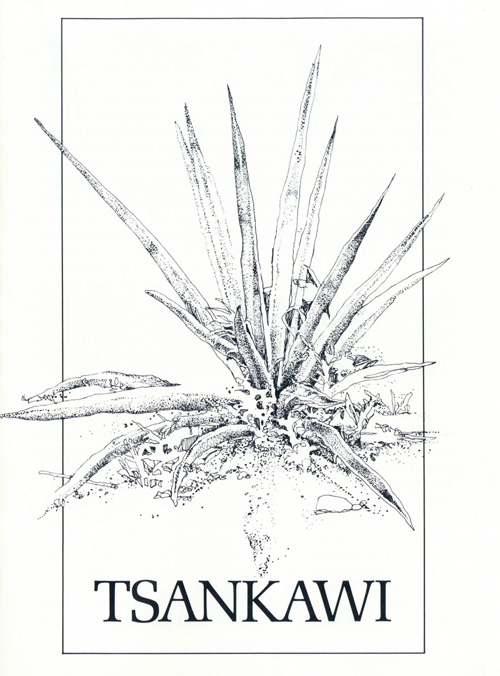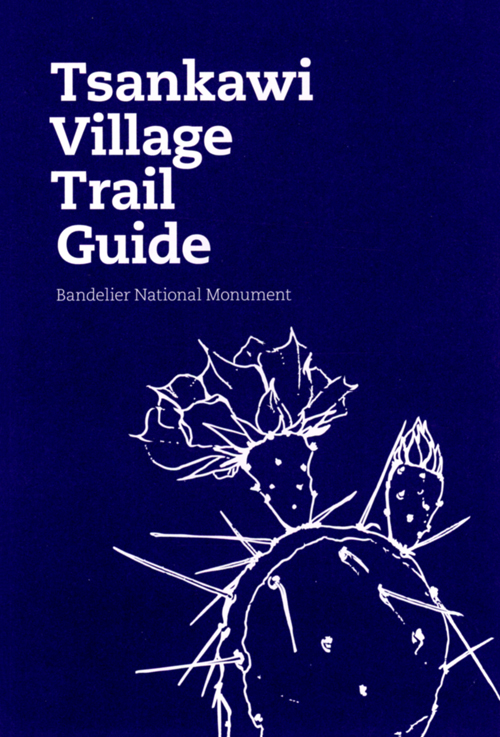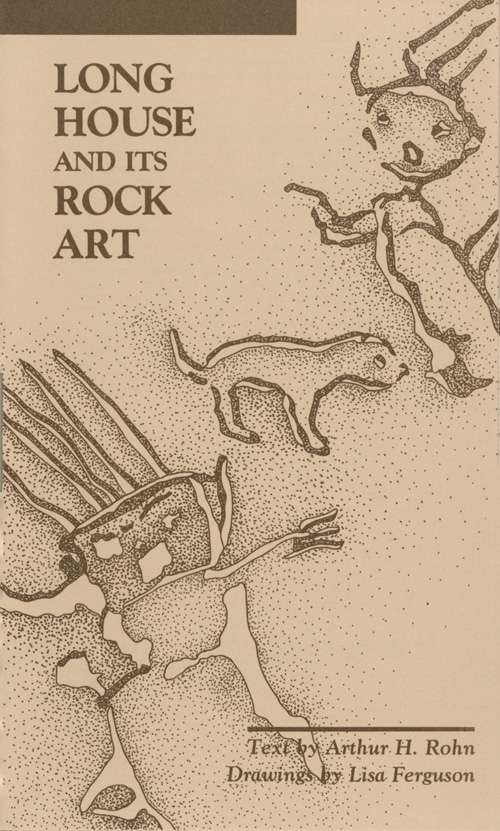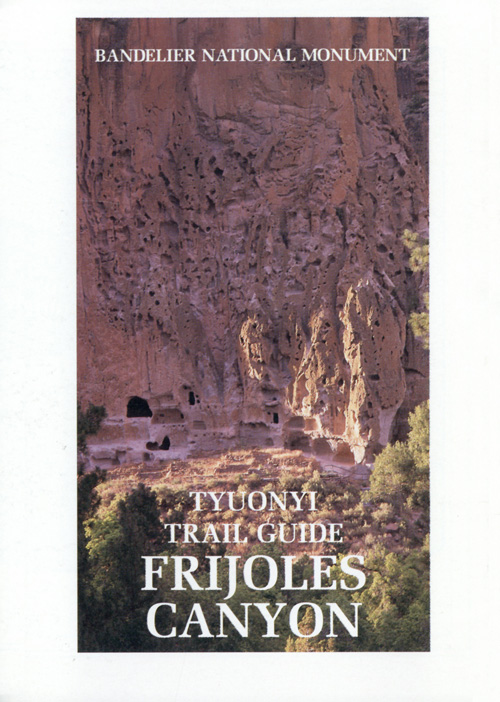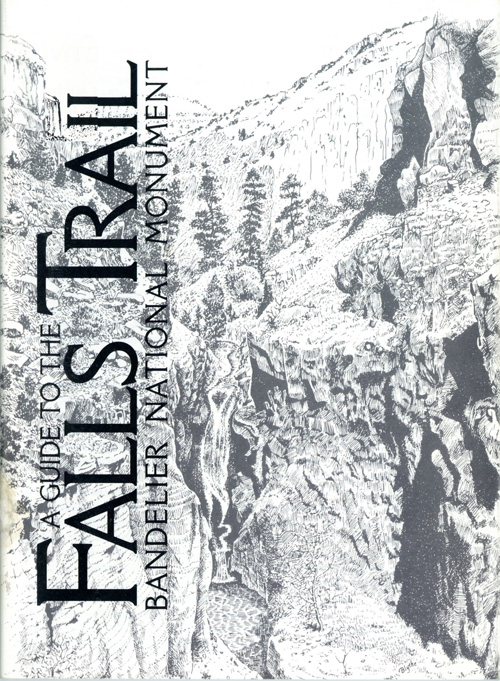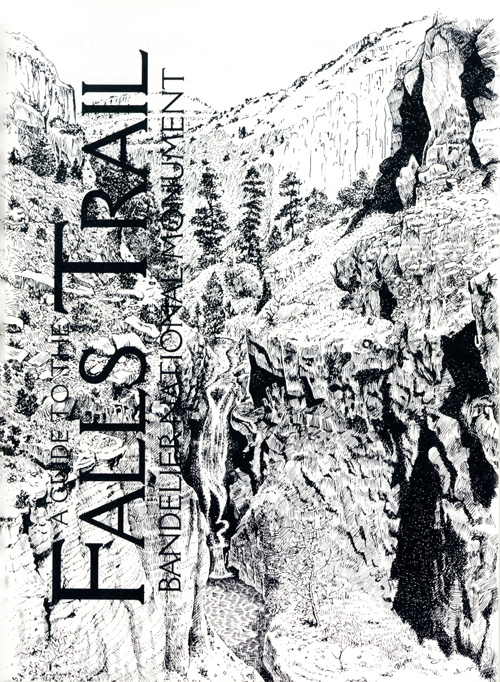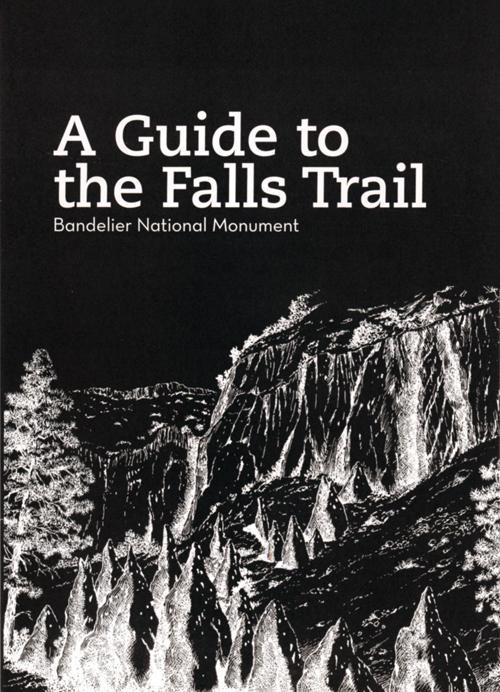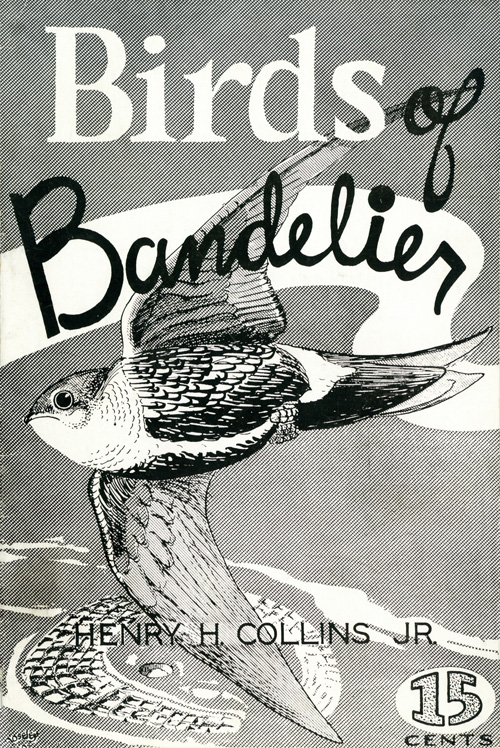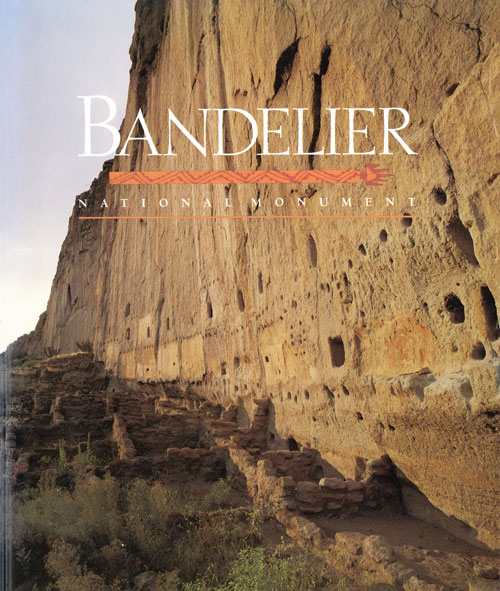|
Bandelier National Monument New Mexico |
 |
 NPS photo | |
Ancestral Pueblo People
The Pueblo people have lived in the Southwest for many centuries. Archeologists think they are descended from groups of hunters and gatherers who came into the region over 10,000 years ago. The Pueblo people themselves say they have always been here. Ancestral Pueblo people lived in parts of what are now New Mexico, Arizona, Colorado, and Utah. Groups varied but shared many traits such as farming, weaving, and pottery-making. Their architecture and pottery reflect the peoples' diversity over time and from place to place. Early archeologists, studying the old dwellings for clues about their residents, adopted the Navajo term "Anasazi" to refer to the ancestors of Pueblo people before the coming of the Spanish. Many Pueblo people today consider the term disrespectful, so now "Ancestral Pueblo people" is used.
Ancestral Pueblo people in and around Bandelier, like Pueblo ancestors elsewhere, were farmers who grew maize (corn), beans, and squash. They supplemented their diet with native plants and by hunting deer, rabbits, other mammals, and birds. Cotton was cultivated and woven into garments. The people made winter blankets ingeniously woven of yucca-fiber string twisted with turkey feathers or strips of rabbit skin. They fashioned tools, including a wide variety of axes, mauls, and knives, from animal bones, wood, and local stones such as obsidian and basalt. They acquired other items, including shells, turquoise, and parrots, through trade networks that ranged as far as centra! Mexico and Baja California.
Archeological surveys show at least 3,000 sites in Bandelier, but not all were inhabited at the same time. For generations these people lived in small, scattered settlements of perhaps one or two families each. As the population grew, people began coming together in larger groups, and, by the mid-1200s, villages often included as many as 40 rooms.
The following 250 years saw fewer and larger villages, with some exceeding 600 rooms. In Bandelier the villages of Tyuonyi (QU-weh-nee) and Tsankawi (SAN-kuh-wee) and their adjacent cave dwellings exemplify this latest period. By the mid-1500s the people who lived there had moved on, settling into new homes in villages along the Rio Grande River. Soon afterward the Spanish colonized New Mexico, bringing immense change to the indigenous people of the Southwest.
No written records existed before the Spanish arrived, but, in their oral traditions today, Pueblo people remember the places where their ancestors lived. The Pueblos of Cochiti, San Felipe, Santo Domingo, San Ildefonso, Santa Clara, and Zuni all have strong ties to Bandelier. Representatives from these Pueblos work closely with park staff to make decisions affecting their ancestral homelands. These Pueblos all have great regard for the dwellings in Bandelier and ask you to treat the area with respect and care.
"Spiritually, our ancestors still live here at Bandelier. You see reminders of their presence here—their homes, their kivas, and their petroglyphs. As you walk in their footsteps, value the earth beneath you and show everything the same respect we do when we re-visit this sacred place."
—Affiliated Pueblo Committee
"The Grandest Thing I Ever Saw"
Forty-year-old self-taught anthropologist and historian Adolph F.A. Bandelier came to New Mexico Territory in 1880, sponsored by the Archeological Institute of America. His ambitious goal was to trace the social organization, customs, and movements of southwestern and Mexican peoples. He traveled and studied throughout the region, tramping canyons and mesas, living and working among many American Indian groups, and delving into document archives. Looking back on his first 18 months in the field, Bandelier tallied visits to 166 archeological sites in New Mexico, Arizona, and Mexico. "I am dirty, ragged, and sunburnt, but of best cheer. My life's work has at last begun."
Adolph F.A. Bandelier was born in Switzerland in 1840 and grew up in Illinois. He was obligated to work in his father's businesses but read, corresponded, and published in anthropology. In 1880 he took up the southwest fieldwork that became his life's passion.
Men from Cochiti Pueblo guided Bandelier to their ancestral homes in Frijoles Canyon in 1880. Its sheer cliffs, year-round stream, and distinctive cave-room architecture, captured his imagination. In 1890 he made the canyon and dwellings the scene of his novel, The Delight Makers, depicting Pueblo life in pre-Spanish times. Bandelier left New Mexico in 1892 and went on to studies in Peru and Bolivia. In his seventies, he went to Seville, Spain, to study early Spanish records of the Americas. He died there in 1914.
Bandelier's pioneering work is now relatively unknown to the public, but it established the foundation for much of modern southwestern archeology. Dr. Edgar Lee Hewett, a prominent southwestern archeologist, directed several excavations in Frijoles Canyon in the early 1900s. He saw the need to preserve these ancestral Pueblo sites and was instrumental in getting Bandelier National Monument established in 1916.
Exploring Bandelier
The Monument Today There was no road into Frijoles Canyon until the mid-1930s when the Civilian Conservation Corps (CCC) built one, along with trails, the visitor center, and a lodge. The increasing number of visitors has changed the way many buildings are used, but the handsome Pueblo revival-style structures and CCC trails still serve the park.
As more people visit each year, parking lots, facilities, and even some trails are strained to accommodate them. Protection is a continuing struggle. Park managers face challenges in backcountry areas too. Livestock grazing from before the park was created contributed to heavy soil erosion now occurring at lower elevations. Severe wildfires result from forests grown unnaturally dense after decades of fire suppression. Fires in 1977, 1996, and 2011 together burned more than 60 percent of the park. In 2000 a fire that began in Bandelier traveled northeast along the mountain slopes and through neighborhoods in Los Alamos. Wildlife populations are affected by park management and by what goes on outside the park boundary. With today's challenges, preserving the monument is a job for more than just the park staff. You, too, can help by respecting regulations and taking the time to learn about the cultural and natural resources.
Getting Here Bandelier National Monument is 48 miles northwest of Santa Fe, New Mexico. From Santa Fe, go north on US 285/84 to Pojoaque, then west on NM 502 and south on NM 4. From Albuquerque, you can reach the park by driving through the Jemez Mountains on NM 4. Take I-25 north of Albuquerque to NM 550 to NM 4. The road is paved, but ask about road conditions before taking the mountain route in winter. If using GPS in this area, be sure to double-check with a road map.
When To Visit The park is open year-round except December 25 and January 1. The busiest time is spring into fall. There may be a shuttle service during these times, since parking in the visitor center is not sufficient for holiday weekends and other days with heavy visitation. Check the park website for possible shuttle information. Winter can be snowy and cold, but it offers more solitude; snow is cleared from a portion of the Main Loop Trail. Summer temperatures are often in the 80s to 90s°F, and afternoon thunderstorms are common. Fall offers cooler, blue-sky days and crisp nights. The park remains busy into November.
Where To Start The visitor center in Frijoles Canyon is a good place to start your visit. Staff can help you plan your time in the park. To help orient you, there are trail guides, videos, museum exhibits, and a park store that offers a large selection of publications and other items related to the Bandelier area. The visitor center is usually open from 9 am to 4:30 pm, and may have longer hours of operation in other seasons. Service animals are welcome.
Things To See and Do Bandelier is unusual in that it has only three miles of public roads within its 33,750 acres, but 70 miles of trails. This network of trails, both short and long, invites you to explore the park. There are Ancestral Pueblo dwellings within a short, easy walk of the visitor center.
The closest archeological site is 400 yards from the visitor center, and the paved 1.2-mile Main Loop Trail to Tyuonyi and the cliff dwellings can be walked in about an hour. Part of this trail is accessible for wheelchairs. You may buy a guidebook about the canyon and the people who lived there. Extending your walk a half-mile up Frijoles Canyon brings you to Alcove House (formerly called Ceremonial Cave), a cliff dwelling reached only by climbing long wooden ladders. Also popular and of moderate length, the Falls Trail leads to Frijoles Canyon's Upper Falls, focusing on scenery and geology rather than early inhabitants. A booklet that explains interesting geologic features and identifies some native plants is on sale. The walk to the Upper Falls, about three miles round-trip, takes about two hours.
Tsankawi, a separate section of the monument on NM 4 about 11 miles north of the main entrance, offers a 1.5-mile loop walk on a more primitive trail. You can see a large unexcavated village, cave dwellings, and many petroglyphs (drawings carved into rock). A guidebook is available.
Hikers who have more time and stamina may venture into the park's backcountry. Seventy percent of Bandelier is part of the National Wilderness Preservation System. Many areas can be reached by day hikes, and backpacking is allowed after obtaining a wilderness permit at the visitor center. The terrain is generally rugged with steep canyons, and the average elevation, 7,000 feet, can make hiking difficult if you are used to lower elevations. But the rewards of finding remote archeological sites and petroglyphs or spotting shy wildlife can make it worthwhile for the well-prepared. Be sure to use a current topographic map for all backcountry travel.
Ask at the visitor center for information on the trails and for regulations for hikers and backpackers. Bicycles, motorcycles, pets, and campfires are not permitted on trails or in the backcountry.
For firearms regulations check the park website.
Planning Your Visit
  (click for larger maps) |
The park offers many things to see and do. Here are some suggestions, based on the amount of time you have to spend.
One Hour
• View the 14-minute movie "This Place
Knows Us" at the visitor center.
• Go through the exhibit room.
• Walk the Main Loop Trail, with the self-guiding
booklet.
Two Hours
• View the 14-minute movie "This Place
Knows Us" at the visitor center.
• Go through the exhibit room.
• Walk the Main Loop Trail, with the aid of
the self-guiding booklet.
• Continue to Alcove House.
• Return to the visitor center.
Three or Four Hours or More
• View the 14-minute movie "This Place
Knows Us" at the visitor center.
• Go through the exhibit room.
• Walk the Main Loop Trail, with the aid of
the self-guiding booklet.
• Continue to Alcove House.
• Return to the visitor center and hike the
Falls Trail, with the self-guiding booklet.
• Ask rangers at the visitor center information
desk for suggestions on other trails.
Safety Precautions
Bandelier is an archeological area preserved in as natural a condition
as possible, and such conditions can be hazardous. Remain alert, be
cautious, and use common sense. Stay on trails and do not climb among
the dwellings or enter caves unless they are accessible by ladders.
Carry drinking water, even on short trails, especially in hot weather.
Do not drink water from streams unless you purify it. The waterborne
intestinal parasite Giardia lamblia is found in Bandelier.
Regulations
• Climbing on walls or cliffs is prohibited. Stay on trails.
• Federal law prohibits removing plants, animals, rocks, or other natural
or historic features. These are felony offenses.
• Feeding wildlife is prohibited. Squirrels in particular can bite and may
carry plague.
• Pets are restricted to campgrounds, picnic grounds, and parking lots.
They must be leashed at all times. No pets on trails.
• Bicycles and motor bikes are restricted to paved roads. No bikes on
trails.
• Fires are permitted only in designated campgrounds and only in the grills
provided. Firewood collecting is prohibited.
• Permits are required for all overnight trips into Bandelier's
backcountry.
Facilities
The gift shop and snack bar are open year-round. There is no lodging in
the park. Juniper Campground, located on the mesa above Frijoles Canyon
near the entrance station, may be closed by snow. Ponderosa Group
Campground is for groups of 10 or more; reservations required. In the
picnic areas near the visitor center, fuel stoves are welcome, but not
fires or charcoal; tables are first-come, first-served.
Accessibility We strive to make our facilities, services, and programs accessible to all; call or check our website.
To Learn More about Bandelier
Buy these and other books and maps from the park's nonprofit cooperating
association at the visitor center or visit www.wnpa.org.
• Bandelier National Monument by Patricia Barey is a good source for general readers.
• The Peopling of Bandelier, edited by Robert P. Powers, examines aspects of the area's archeology.
• The Delight Makers is Adolph Bandelier's historical novel, first published in the 1890s. It is still in print.
• A Trails Illustrated topographic map is available for hikers, as is the hikers' guide, A Guide to Bandelier National Monument, by Dorothy Hoard.
Source: NPS Brochure (2018)
|
Establishment
Bandelier CCC Historic District — 1987 |
For More Information Please Visit The  OFFICIAL NPS WEBSITE |
Brochures ◆ Site Bulletins ◆ Trading Cards

Documents
A Flora of Bandelier National Monument (Brian F. Jacobs, March 14, 1989)
A Reexamination of Bandelier's Studies of Ancient Mexico (©Clarissa P. Fuller, PhD Thesis University of New Mexico, 1950)
Administrative History: Bandelier National Monument (HTML edition) Southwest Cultural Resources Center Professional Papers No. 14 (Hal Rothman, 1988)
Air Tour Management Plan and Environmental Assessment, Bandelier National Monument (Draft) (July 2023)
An Assessment of Cultural Resources in Cochiti Reservoir (Jan V. Biella and Richard Chapman, November 1975)
Antiquities of the Jemez Plateau, New Mexico Bureau of American Ethnology Bulletin No. 32 (Edgar L. Hewitt, 1906)
Archeological Assessment of Bandelier National Monument (C. Britt Bousman, Paul Larson and Frances Levine, April 1974)
Archeological Investigations in Cochiti Reservoir, New Mexico, Volume 1: A Survey of Regional Variability (Jan V. Biella and Richard C. Chapman, eds., 1977)
Archeological Investigations in Cochiti Reservoir, New Mexico, Volume 4: Adaptive Change in the Northern Rio Grande Valley (Jan V. Biella and Richard C. Chapman, eds., 1979)
Assessment of Vegetation Response to Wildfire at Bandelier National Monument, New Mexico: Case Study of the Las Conchas Fire (©Gladys Valentin-Gonzalez, Master's Thesis University of New Mexico, May 2018)
Biographical Sketch and Bibliography of Adolphe F.A. Bandelier (F.W. Hodge, extract from New Mexico Historical Review, Vol. 7 No. 4, 1932, ©University of New Mexico)
Cerro Grande Prescribed Fire Investigation Report, Bandelier National Monument (May 18, 2000)
Circular Relating to Historic and Prehistoric Ruins of the Southwest and Their Preservation (Edgar L. Hewitt, 1904)
Conflict on the Pajarito: Frank Pinkley, the Forest Service, and the Bandelier Controversy, 1925-32 (Hal Rothman, extract from Journal of Forest History, v. 29, no. 2, April 1985, ©Forest History Society, all rights reserved)
Contributions of the Bandelier Archeological Survey
1. The Pajarito Plateau: A Bibliography (Frances Joan Mathien, Charlie R. Steen and Craig D. Allen, 1993)
2. Bandelier Archaeological Excavation Project: Research Design and Summer 1988 Sampling Reports of Investigations No. 61 (Timothy A. Kohler, ed., Department of Anthropology, Washington State University, Pullman, 1989)
3. An Analysis of Variability and Condition of Cavate Structures in Bandelier National Monument Intermountain Cultural Resources Center Professional Paper No. 53 (H. Wolcott Toll, 1995)
4. Glimpses into the History of the 1908 Fieldwork at Yapashi, Bandelier National Monument In Puebloan Past and Present: Papers in Honor of Stewart Peckham (Frances Joan Mathien, edited by Meliha S. Duran and David T. Kirkpatrick, pp. 121-132, Papers of the Archeological Society of New Mexico: 17. Albuquerque. 1991)
5. Bandelier Archaeological Excavation Project: Summer 1989 Excavations at Burnt Mesa Pueblo Reports of Investigations No. 62(Timothy A. Kohler, ed., Department of Anthropology, Washington State University, Pullman. 1990)
6. Bandelier Archaeological Excavation Project: Summer 1990 Excavations at Burnt Mesa Pueblo and Casa del Rito Reports of Investigations No. 64 (Timothy A. Kohler and Matthew J. Root, eds., Department of Anthropology, Washington State University, Pullman, 1992)
7. In the Land of the Delight Makers: An Archaeological Survey in the American West (Joseph Courtney White, University of Utah Press, Salt Lake City)
8. Papers on the Early Classic Period Prehistory of the Pajarito Plateau, New Mexico Reports of Investigations No. 65 (Timothy A. Kohler and Angela R. Linse, eds., Department of Anthropology, Washington State University, Pullman, 1993)
9. The Bandelier Archeological Survey, Volume I Intermountain Cultural Resources Management Professional Paper No. 57 (Robert P. Powers and Janet D. Orcutt, eds., 1999)
9. The Bandelier Archeological Survey, Volume II Intermountain Cultural Resources Management Professional Paper No. 57 (Robert P. Powers and Janet D. Orcutt, eds., 1999)
10. The Archaeology of a "Destroyed" Site: Surface Survey and Historical Documents at the Civilian Conservation Corps Camp, Bandelier National Monument, New Mexico (Monica L. Smith, Historical Archaeology 35(2):31-40. 2001)
11. The Historic Period at Bandelier National Monument Intermountain Cultural Resources Management Professional Paper No. 63 (Monica L. Smith, 2002)
12. Village Formation on the Pajarito Plateau, New Mexico: Archaeology of Bandelier National Monument (Timothy A. Kohler, ed. University of New Mexico Press, Albuquerque. 2004)
Bandelier: Excavations in the Flood Pool of Cochiti Lake, New Mexico (Lyndi Hubbell and Diane Traylor, eds., NPS Southwest Cultural Resources Center, 1982)
Ecosystems of the Pajarito Plateau and East Jemez Mountains: Linking Land and People (Teralene S. Foxx, November 2002)
Effects of Wildfire on the Hydrology of Capulin and Rito de los Frijoles canyons, Bandelier National Monument, New Mexico USGS Water-Resources Investigations Report 2002-4152
Effects of wildfire on the hydrology of Frijoles and Capulin canyons in and near Bandelier National Monument, New Mexico USGS Fact Sheet 141-02
Environmental Assessment and Draft Plan Regarding the Management of the Tsankawi Unit, Bandelier National Monument (March 30, 2000)
Evaluation of the landslide potential in Capulin Canyon following the Dome Fire, Bandelier National Monument, New Mexico USGS Open-File Report 98-42
Evaluation of the potential for debris and hyperconcentrated flows in Capulin Canyon as a result of the 1996 Dome fire, Bandelier National Monument, New Mexico (HTML edition) USGS Open-File Report 97-136
Excavations at Rainbow House, Bandelier National Monument, New Mexico (Louis R. Caywood, January 1966)
Fire Ecology at Bandelier National Monument Final Report (Teralene S. Foxx and Loren D. Potter, February 15, 1978)
Foundation Document, Bandelier National Monument, New Mexico (June 2015)
Foundation Document Overview, Bandelier National Monument, New Mexico (March 2016)
Fuels, Fire Severity, and Invasive Plants within the Cerro Grande Fire, Los Alamos, New Mexico (Philip N. Omi, Erik J. Martinson, Mohammed A. Kalkhan, Geneva W. Chong, Molly Hunter and Thomas J. Stohlgren, from Tall Timbers Fire Ecology Conference Proceeding, Vol. 22, 2004)
Geologic Resources Inventory Report, Bandelier National Monument NPS Natural Resource Report NPS/NRPC/GRD/NRR-2015/1036 (K. KellerLynn, September 2015)
Historic Handbook #23: Bandelier National Monument (Kittridge A. Wing, 1955, reprint 1957)
Historic Structure Report: CCC Buildings: Bandelier National Monument (Laura Soullière Harrison, Randall Copeland and Roger Buck, 1988)
Historical and Modern Disturbance Regimes of Piñon-Juniper Vegetation in the Western U.S. (William Romme, Craig Allen, John Bailey, William Baker, Brandon Bestelmeyer, Peter Brown, Karen Eisenhart, Lisa Floyd-Hanna, David Huffman, Brian Jacobs, Richard Miller, Esteban Muldavin, Thomas Swetnam, Robin Tausch and Peter Weisberg, May 2007)
Improved Method for Repairing Wooden Structural Beams in CCC NHL District (2011)
In the Land of the Ancient Cliff Dweller Bandelier National Monument (HTML edition) (1923, revised 1925)
Integrating Remote Sensing, GIS, and Spatial Statistics: A Case Study of Invasive Plants and Wildfire on the Cerro Grande Fire, Los Alamos, New Mexico (Mohammed A. Kalkhan, Erik J. Martinson, Philip N. Omi, Thomas J. Stohlgren, Geneva W. Chong and Molly A. Hunter, from Tall Timbers Fire Ecology Conference Proceeding, Vol. 22, 2004)
Junior Ranger Challenge Booklet (2nd and 3rd Grade), Bandelier National Monument (Date Unknown; for reference purposes only)
Junior Ranger Challenge Booklet (4th to 6th Grade), Bandelier National Monument (Date Unknown; for reference purposes only)
Junior Ranger Challenge Booklet (For All Ages), Bandelier National Monument (Date Unknown; for reference purposes only)
Junior Ranger Challenge Booklet (PreK to 1st Grade), Bandelier National Monument (Date Unknown; for reference purposes only)
Key Sources of Bandelier's History of the Southwest (Ernest J. Burrus, S.J., extract from New Mexico Historical Review, Vol. 60 No. 1, 1985, ©University of New Mexico)
National Monuments of New Mexico: The Bandelier National Monument (extract from El Palacio, Vol. 5 No. 12, October 12, 1918)
National Monuments Redesignated as National Parks: Insights for Bandelier National Monument (Headwaters Economics, March 2019)
National Register of Historic Places Nomination Forms
Bandelier National Monument (Dennis B. Davies, February 24, 1970)
Bandelier National Monument CCC Historic District (Laura Soulliere Harrison, 1985)
Natural Resource Condition Assessment, Bandelier National Monument NPS Natural Resource Report NPS/BAND/NRR-2015/1000 (Brian Jacobs, Barbara Judy, Stephen Fettig, Kay Beeley, Collin Haffey, Catherin Schwemm, Jean Palumbo and Lisa Thomas, eds., August 2015)
Park Newspaper
2006: Winter-Spring, Summer-Winter
2007: Spring-Summer, Summer-Fall, Fall-Winter
2008: Summer-Fall, Fall-Winter
2009: Spring-Summer
2010: Summer-Fall-Winter
Piñon-Juniper Woodland Restoration Studies: a watershed scale, multi-disciplinary approach, Bandelier National Monument, New Mexico (Brian F. Jacobs, Richard G. Gatewood, Brian K. Hastings, Christian Julius, Paula K. Kleintjes, Stephen M. Fettig and Craig D. Allen, May 2002)
Prehistory of El Rito de los Frijoles Bandelier National Monument Southwestern Monuments Association Technical Series No. 1 (J.W. Hendron, May 12, 1940)
Preliminary evaluation of the landslide potential in Capulin Canyon following the Dome fire, Bandelier National Monument, New Mexico USGS Open-File Report 97-141
Prescribed Fire Information Bulletin (Fall 2005)
Recommendations on the National Register Eligibility of the Mission 66 District at Bandelier National Monument (Emily J. Brown, Kim Sorvig and Richard G. Higgins, 2009)
Remote Sensing: Multispectral Analyses of Cultural Resources — Supplement No. 5 Part 1: An Airborne Spectral Analysis of Settlement Sites in Chaco Canyon, Part 2: Remote Detection of Prehistoric Sites in Bandelier National Monument (Part 1: Stanley A. Morain, Thomas K. Budge and Amelia Komaerik, Part 2: Stanley A. Morain, Charles Nelson, Mike E. White and Amelia M. Komarek, 1981)
Replacement of Motor and Pedestrian Bridges Environmental Assessment (February 2015)
Reptiles and Amphibians of Bandelier National Monument (undated)
Resource Briefs
Acoustic Environment and Soundscape (undated)
Recent Climate Change Exposure of Bandelier National Monument (July 24, 2014)
Night Skies and Photic Environment (undated)
Resources Management Plan and Environmental Assessment for Bandelier National Monument (1988)
Shaded Relief Map: Bandelier National Monument & Vicinity, NM Scale: 1:24,000 (USGS, 1978)
Study of Traditionally Associated Native American Communities, Ethnographic Overview and Assessment: Bandelier National Monument (Thomas Merlan and Frances Levine, April 2000)
The 1977 La Mesa Fire Study: An Investigation of Fire and Fire Suppression Impact on Cultural Resources in Bandelier National Monument Southwest Cultural Resources Center Professional Paper No. 28 (Diane Traylor, Lyndi Hubbell, Nancy Wood and Barbara Fiedler, 1990)
The Archaeology of a "Destroyed" Site: Surface Survey and Historical Documents at the Civilian Conservation Corps Camp, Bandelier National Monument, New Mexico (Monica L. Smith, extract from Historical Archaeology, Vol 35 No. 2, 2001)
The Cerro Grande Prescribed Fire (extract from People, Land & Water, June 2000)
The Delight Makers (Adolf F. Bandelier, 1890, 1916)
The Excavations at El Rito De Los Frijoles in 1909 (Edgar L. Hewett, October 1, 1909)
The Excavations at Tyuonyi, New Mexico, in 1908 (Edgar L. Hewett, extract from American Anthropologist, Vol. 11 No. 3, Jul.-Sep. 1909)
The Grandest Thing I Ever Saw: Bandelier National Monument Historic Resource Study (Aspen CRM Solutions and Bandelier CR Staff, 2012)
The Historic Period at Bandelier National Monument Intermountain Cultural Resources Management Professional Paper No. 63 (Monica L. Smith, 2002)
The La Mesa Fire: Studies and Observations from 1975 through 2012 (Teralene S. Foxx, Leslie A. Hansen, Rebecca Oertel, Colin Haffey and Kay Beeley, June 19, 2013)
The "Lost" Manuscript of Adolph Bandelier (Madeline Rodack, extract from New Mexico Historical Review, Vol. 54 No. 3, 1979, ©University of New Mexico)
The Pajarito or Cliff Dwellers' National Park Proposal, 1900-1920 (Thomas L. Altherr, extract from New Mexico Historical Review, Vol. 60 No. 3, 1985, ©University of New Mexico)
The Pajarito Plateau: A Bibliography Southwest Cultural Resources Center Professional Paper No. 49 (Frances Joan Mathien, Charlie R. Steen and Craig D. Allen, 1993)
The Role of Biofilms and Lichens in the Preservation of Archaeological Features in the Bandelier Tuff, Bandelier National Monument (Douglas Porter, David Broxton, Angelyn Bass, Deborah Neher, Tom Weicht, Patrick Longmire, Michael Spilde and Rebecca Dominque, May 30, 2014)
The Truth about Pueblo Indians: Bandelier's Delight Makers (Russell Saxton, extract from New Mexico Historical Review, Vol. 56 No. 3, 1981, ©University of New Mexico)
Topographic Map: Bandelier National Monument & Vicinity, NM Scale: 1:24,000 (USGS, 1978)
Tsankawi Unit Management Plan and Environmental Assessment, Bandelier National Monument (October 2014)
Water Resources Foundation Report, Bandelier National Monument NPS Natural Resource Technical Report NPS/NRPC/WRD/NRTR-2007/060 (Don Weeks, October 2007)
Wilderness Recommendation, Bandelier National Monument, New Mexico (August 1972)
Wilderness Study, Bandelier National Monument (May 1971)
Yet Another Bandelier Story: A Research Note (Elizabeth M. Lange, Charles H. Lange and Carroll L. Riley, extract from New Mexico Historical Review, Vol. 63 No. 1, 1988, ©University of New Mexico)
Books

band/index.htm
Last Updated: 29-Aug-2024
